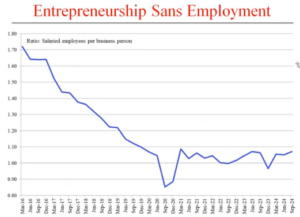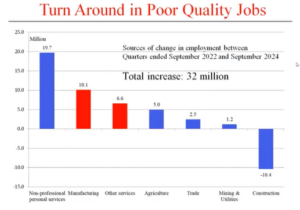
India’s labour market has experienced major changes in recent years, marked by shifts in employment patterns and sectoral imbalances. While overall employment numbers have shown signs of recovery post-COVID-19, a closer look reveals significant issues in job quality, sectoral disparities, and gender-based inequalities. These trends need to be examined to understand India’s unemployment problem and the policy interventions needed to create a resilient and inclusive workforce.
Since 2016, India’s workforce has faced multiple shocks, leading to an initial steady decline in employment, followed by a sharp drop due to COVID-19 lockdowns. In 2016, approximately 400 million Indians were employed, but demonetisation and GST led to gradual job losses, impacting sectors like small trade and informal labour disproportionately.
By 2020, the pandemic’s lockdowns drove employment figures to an all-time low, with some recovery emerging only after restrictions eased. As of 2023, employment numbers have stabilised above pre-2016 levels, yet the increase in employment primarily reflects low-paying, insecure jobs that contribute little to economic security or social mobility.
READ I Tariffs over allies: A Trump victory could reshape the world economy
Persistent quality gaps in employment
A major concern in India’s labour market is the over-representation of workers in low-income roles, which offer limited economic security. Farmers and wage labourers make up a significant share of this poor-quality employment, defined by limited pay and low job security. In contrast, better-paying roles among business owners and salaried employees make up a much smaller portion of the workforce. This imbalance indicates that while employment numbers may appear healthy, the quality of these jobs remains low, underscoring the need for policy interventions that can provide stable, better-paying roles across sectors.

Economic disruptions have reshaped India’s employment scenario, especially among vulnerable populations like small traders and wage labourers. The combined effects of demonetisation, GST implementation, and pandemic lockdowns caused a mass exodus from urban areas, with displaced workers returning to rural areas. Many of these returning workers took up farming or informal roles in agriculture, reversing decades of economic progress that aimed to shift labour from agriculture to more productive sectors. This shift is not a reflection of agricultural sector growth but rather a lack of viable employment options in urban areas, a reality that underscores the economy’s inability to absorb surplus labour during periods of economic stress.
Entrepreneurship in name, not in practice
India has seen a surge in self-reported business owners since 2016, attributed in part to government schemes like the Mudra loans, which enabled small traders to reclassify themselves as entrepreneurs. However, many of these small enterprises lack the ability to expand or create additional jobs, evident from the low ratio of salaried employees to businesspersons, which has stagnated at around one employee per businessperson.

This reflects a pattern where many self-declared entrepreneurs are in fact subsistence traders or hawkers, rather than drivers of employment growth. Thus, while entrepreneurship is a critical economic pillar, the quality and scale of business activity in India remain low.
The service sector’s recent growth in employment, particularly in wholesale and retail trade, offers some relief, yet most jobs within this sector lack job security and competitive wages. Meanwhile, construction, historically a key employer of low-skilled labour, has shown signs of fatigue, with many returning rural workers unable to find employment in the industry. The oversupply of labour in agriculture and construction points to an urgent need to develop more robust employment options in urban areas and in emerging sectors that can sustainably absorb this surplus labour.
Gender inequality and unfair conditions
The gender gap in employment remains a significant issue, with women overrepresented in low-paying, informal roles such as domestic work. Despite a small rise in female employment in recent years, gender-based disparities persist, with female workers facing much higher unemployment rates than their male counterparts. In the period from September 2022 to 2024, women accounted for a remarkable 41% of new entrants in the workforce, though they remain overrepresented in low-wage sectors. Female labour participation remains low at 11.2%, compared to 68% for men, reflecting the structural and social barriers that restrict women’s access to secure, well-paying jobs.
The current employment situation provides a critical opportunity for India to address the qualitative aspects of its labour market. The primary focus should be on improving the stability and quality of jobs, ensuring fair wages, and fostering an inclusive environment for women in the workforce. Policymakers might consider the following strategies:
Enhance Job Quality in Emerging Sectors: Investments in manufacturing, technology, and industrial services are essential to create quality jobs that offer higher wages and job security. A well-supported shift to these sectors can also reduce the over-reliance on agriculture as a fallback for surplus labour.

Support SMEs and Scale Entrepreneurship: Financial aid, infrastructure support, and vocational training for SMEs can stimulate sustainable entrepreneurship that generates jobs. This support is especially critical in rural areas where the need for job creation is particularly acute.
Focus on Gender Equity in the Labor Market: Addressing the barriers to female workforce participation requires policies that provide affordable childcare, promote flexible work arrangements, and ensure equal pay. Special initiatives to create secure employment for women in traditionally male-dominated industries can help close the gender gap.
Strengthen Urban Employment Opportunities: Urban job markets need investment in infrastructure and service-based industries to absorb labour moving from rural sectors. This investment can reduce the pressure on agriculture and construction to serve as fallback options for displaced workers.
Continuous Data Tracking and Adaptive Policies: Using real-time labour data, such as that collected by CMIE, allows for responsive policy-making that can adapt to labour market shifts. Fast-frequency data collection enables policymakers to respond to employment trends and emerging labour needs with agility.
While India’s recent employment gains are encouraging, the dominance of low-quality, informal jobs reflects the underlying challenges of a labour market in transition. Meeting these challenges requires an approach that emphasises equitable opportunities, gender inclusion, and job quality across sectors. As India seeks to modernise its economy, it must prioritise the creation of a robust labour market that not only meets the needs of today’s workforce but also positions the country for long-term growth and resilience.
(This article is based on a presentation made by Shri Mahesh Vyas, CEO, Centre for Monitoring Indian Economy, at an online event organised by EGROW Foundation, a Noida-based think tank.)
